This wonderful Cornish workshop and museum is dedicated to the legacy of studio pottery trailblazer Bernard Leach
5 great artworks to celebrate a bountiful September harvest
5 great artworks to celebrate a bountiful September harvest
22 Sep 2023
September is the stepping stone from summer heat to autumn leaves, when golden hour is at its brightest. Traditionally, of course, it is also the period for harvest – so what better time to winkle out five great works of art that champion the reaping of what we sow?
For many, harvest remains a key moment of the year and you don’t have to be involved in agriculture for the culture of harvest season to endure.
Foodie events such as the reliably delicious Ludlow Food Festival and countless harvest festivals remain extremely popular.
But what do artists have to say about harvest time and food?
The short answer: a lot. Consider the below, then, a mere taster menu of the bottomless buffet that is the artistic reverence and response to food, harvest and its associated culture.
Fruits of the season
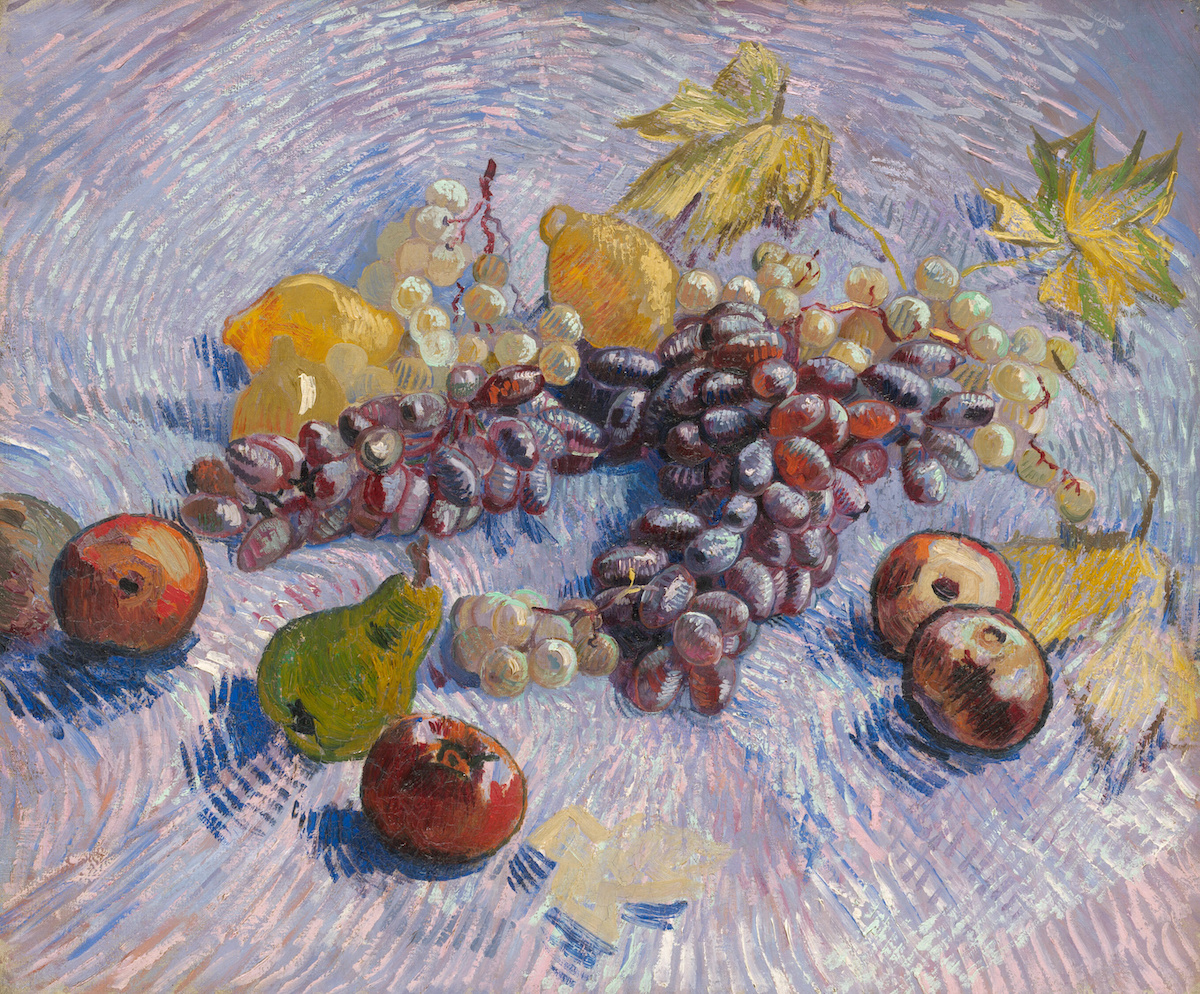 Grapes, Lemons, Pears, and Apples by Vincent van Gogh, 1887. Image: The Art Institute Chicago/gift of Kate L Brewster
Grapes, Lemons, Pears, and Apples by Vincent van Gogh, 1887. Image: The Art Institute Chicago/gift of Kate L Brewster
Look at those powerful brushstrokes and daubs of paint adding light to the luscious fruits: here is a work that could only have come from Vincent van Gogh. He created a series with a focus on fruits of the season and made this particularly tasty painting in the autumn of 1887.
It’s thought this work was one of what Van Gogh’s artist friend Emile Bernard called his ‘violent still lifes’, which he showed in an exhibition at, appropriately enough, a restaurant. Gaze long enough at this work and you can just imagine the tempting scent of those grapes, lemons, pears and apples framed by the ruffled tablecloth on which they have been placed in the autumnal sun.
Butter wouldn’t melt…
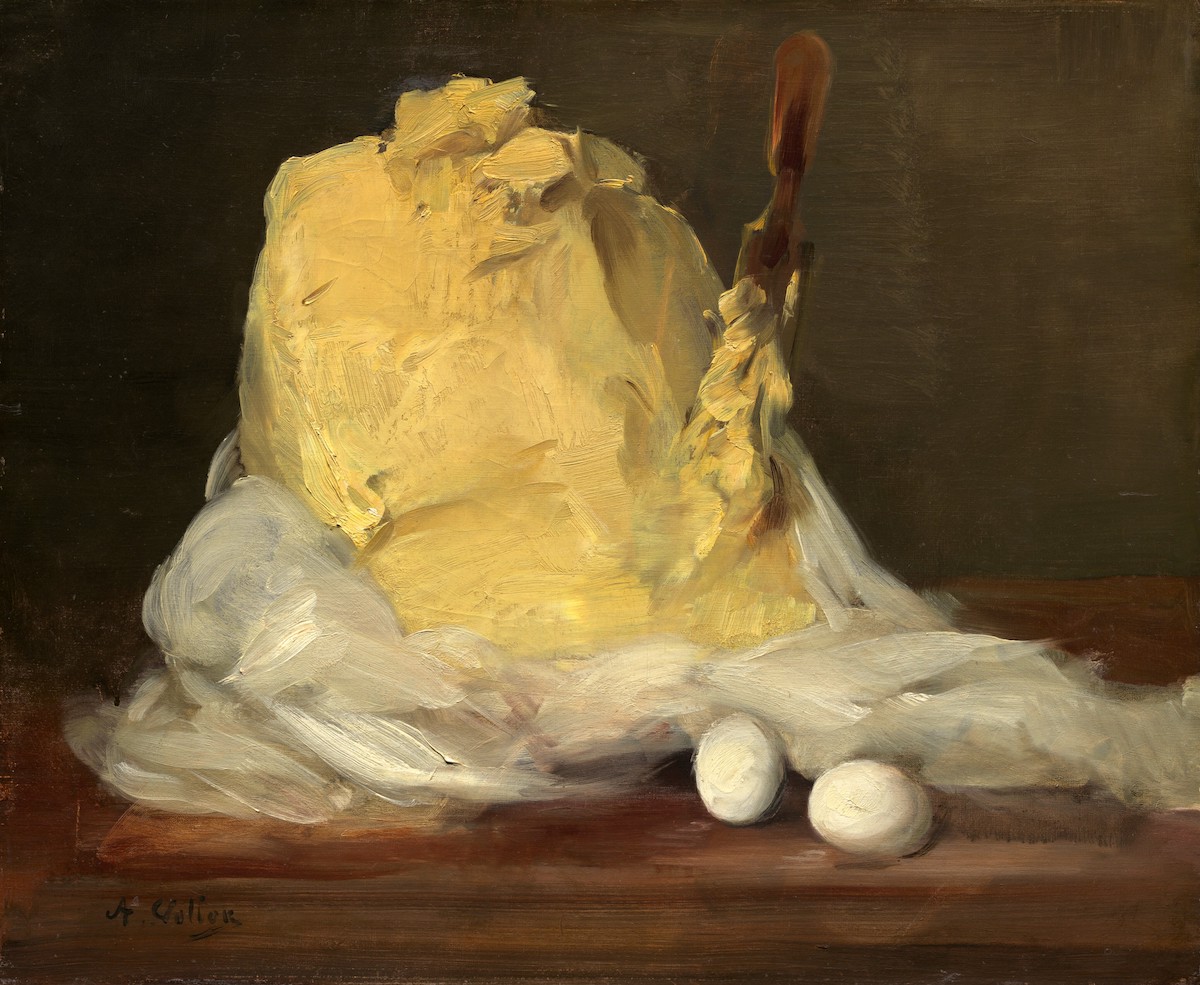 Mound of Butter by Antoine Vollon, 1875–85. Image: The National Gallery of Art/Chester Dale Fund
Mound of Butter by Antoine Vollon, 1875–85. Image: The National Gallery of Art/Chester Dale Fund
To bread, we must add butter. Thick slabs of fresh, golden butter, like the heap found in this French still life that oozes with spreadable texture. Created by Antoine Vollon, a realist celebrated for his still life, landscape and portrait work, it is a beautifully sensuous painting that can almost make the mouth water. Now in the National Gallery of Art’s collection in Washington DC, it combines delicate brushwork with thick marks that have been added to amplify its realness.
That rich yellow colour had its genesis in the plants that grazing cows would eat, and Vollon’s representation is accurate to how most would have seen butter in the late 19th century. Farmers would provide the fresh produce in cheesecloths and the thick markings reveal the hard work that has gone into churning it into a solid.
The apple and the fly
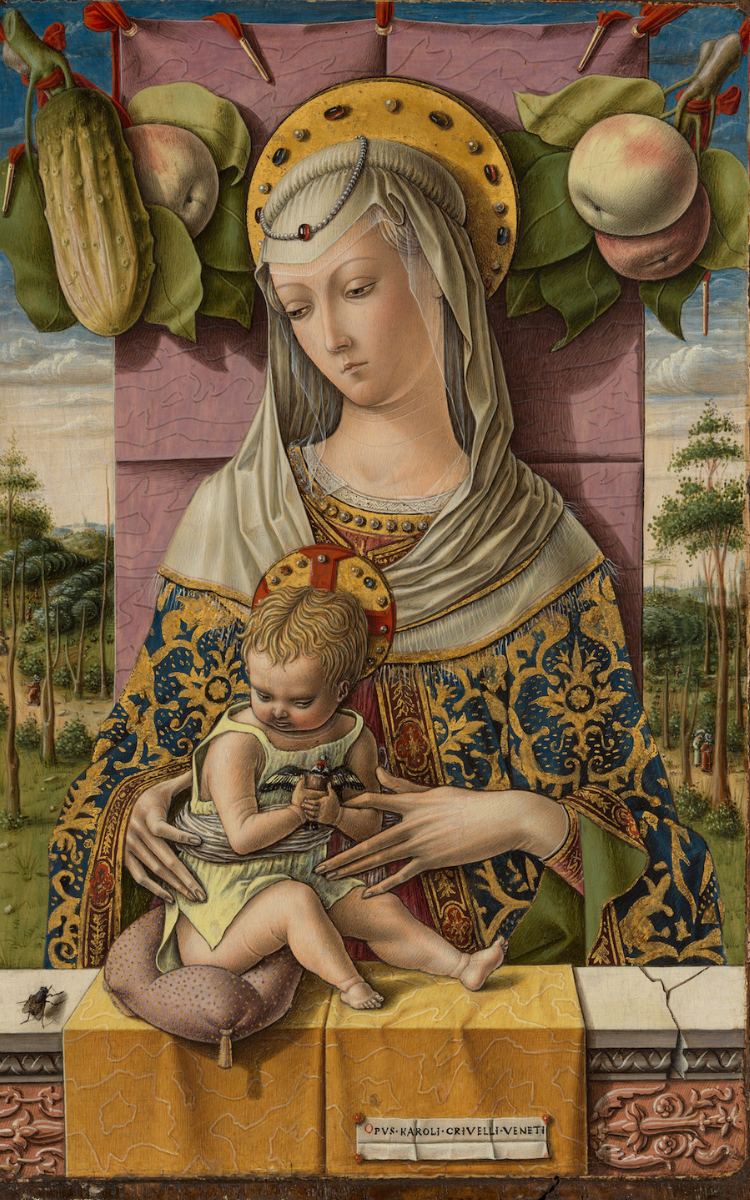 Madonna and Child by Carlo Crivelli, c.1480. Image: The Met Collection/The Jules Bache Collection, 1949
Madonna and Child by Carlo Crivelli, c.1480. Image: The Met Collection/The Jules Bache Collection, 1949
What foodstuff has been recreated most by painters? Impossible to answer with any certainty, but a worthy contender must surely be a fruit of autumn: the apple.
Carlo Crivelli’s depiction of the Virgin Mary and Jesus uses the fruit to its full allegorical potential: a representation of sin that is further supported by the irksome fly that has caught the baby’s attention. A fellow fruit, the cucumber, acts as a symbol of redemption, reinforced by the goldfinch.
Crivelli was no stranger to fruit: he adopted cucumbers, apples, peaches, pears and other produce throughout his work. A painter of the Italian Renaissance, his trademark fruit and defined colour and contour make a stark contrast to his contemporary Giovanni Bellini.
Feast for the gods
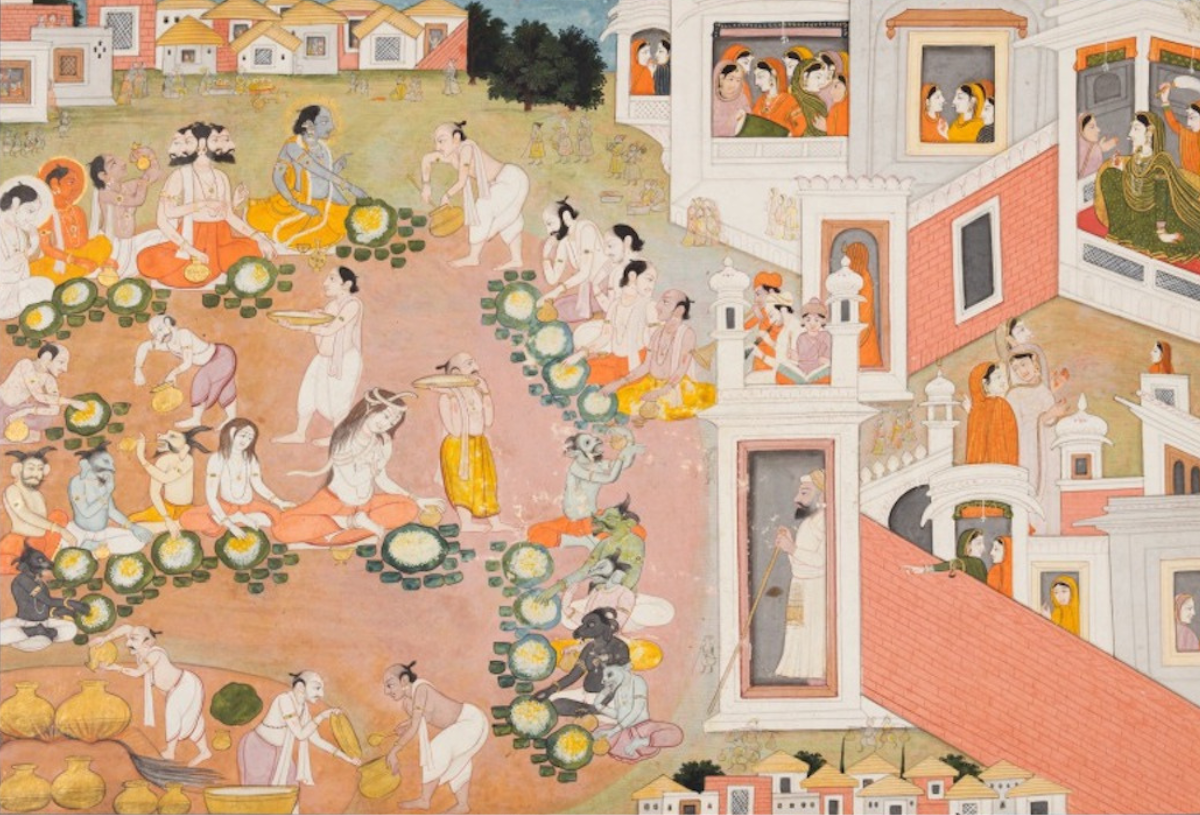 Feast where Vishnu decides he will incarnate as King Dasharatha’s sons, from Chapters 14–15 of the Bala Kanda (Book of Childhood) of a Ramayana (Rama’s Journey) by an unknown artist, c.1810. Image: The Cleveland Museum of Art/purchase and partial gift from the Catherine and Ralph Benkaim Collection/Severance and Greta Millikin Purchase Fund
Feast where Vishnu decides he will incarnate as King Dasharatha’s sons, from Chapters 14–15 of the Bala Kanda (Book of Childhood) of a Ramayana (Rama’s Journey) by an unknown artist, c.1810. Image: The Cleveland Museum of Art/purchase and partial gift from the Catherine and Ralph Benkaim Collection/Severance and Greta Millikin Purchase Fund
Food really is what unites us all: even gods.
This painting from the state of Himachal Pradesh in northern India depicts a feast like no other as Hindu deities gather together for a bite to eat. In the mix are Brahma, the god of creation, recognisable by his four heads; Vishnu, the god of time, with tell-tale blue skin; and, to the far left, Surya and Chandra, the gods of the sun and moon.
They are enjoying a feast called Dhām, prepared by chefs in brass vessels that meet the required standards of purity. The food is served on plates made from leaves. To the right of the scene are the women’s quarters of a palace.
In the Bala Kanda, the first part of one of the two most important epics of Hinduism, this is the moment where Vishnu decides he will incarnate as the sons of King Dasharatha – himself the son of Brahma.
Field of gold
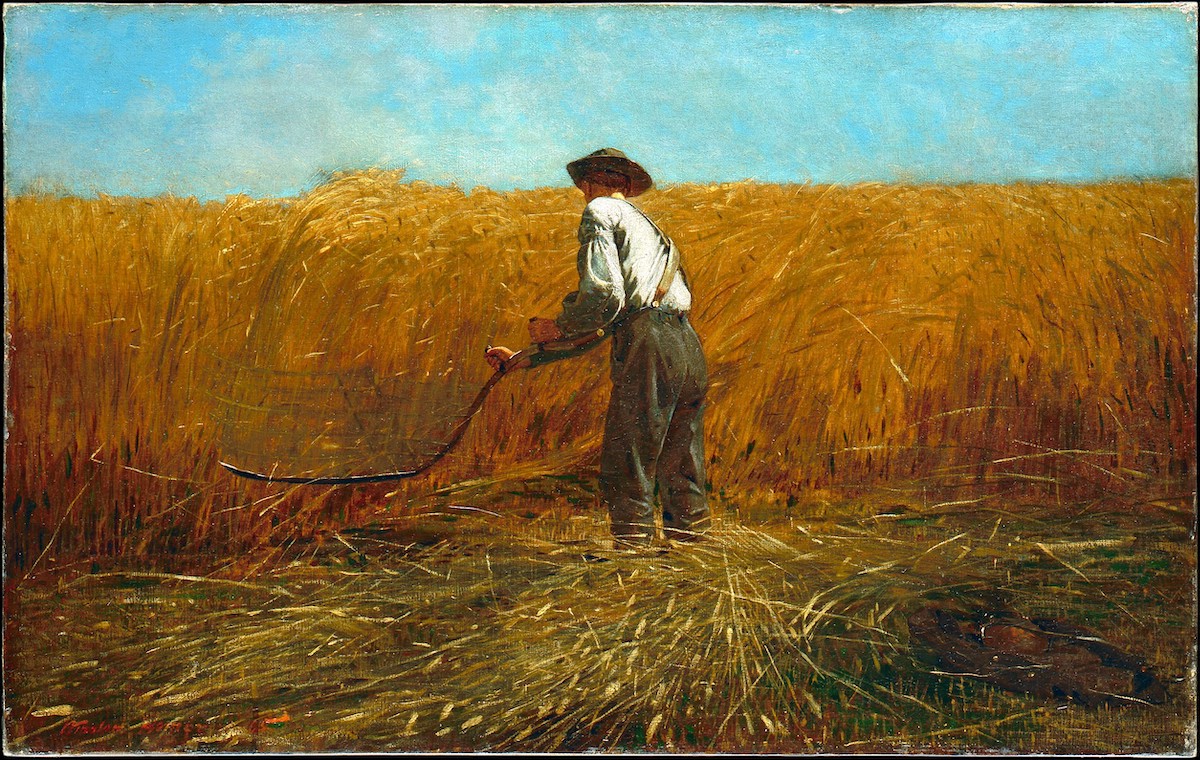 The Veteran in a New Field by Winslow Homer, 1865. Image: Bequest of Miss Adelaide Milton de Groot (1876–1967), 1967/The Met Collection
The Veteran in a New Field by Winslow Homer, 1865. Image: Bequest of Miss Adelaide Milton de Groot (1876–1967), 1967/The Met Collection
We have to include a harvest scene, so here is one with messages that go deep.
At first glance, this image could be a reference to the Ukrainian flag: after all, its clear blue sky and yellow fields are precisely the inspiration behind that now-ubiquitous standard’s colouring.
However, Winslow Homer’s creation has a clearer connection to a different conflict – the American Civil War. Painted in the same year as that battle came to an end, it is a reflection of new beginnings that follow the bloodiness of war. A veteran, identified as such by the Union Army jacket deposited in the right-hand corner, harvests wheat with a scythe that isn’t wholly unlike that held by the Grim Reaper.
As this painting shows, there are all kinds of metaphor related to harvest: reaping what has been sown, preparing for a long winter, engaging in a circle of life, and more. All can, in their own way, be related to a peace that follows war.
About the Author
Ciaran Sneddon
writes for The Arts Society
JOIN OUR MAILING LIST
Become an instant expert!
Find out more about the arts by becoming a Supporter of The Arts Society.
For just £20 a year you will receive invitations to exclusive member events and courses, special offers and concessions, our regular newsletter and our beautiful arts magazine, full of news, views, events and artist profiles.
FIND YOUR NEAREST SOCIETY
MORE FEATURES
Ever wanted to write a crime novel? As Britain’s annual crime writing festival opens, we uncover some top leads
It’s just 10 days until the Summer Olympic Games open in Paris. To mark the moment, Simon Inglis reveals how art and design play a key part in this, the world’s most spectacular multi-sport competition



